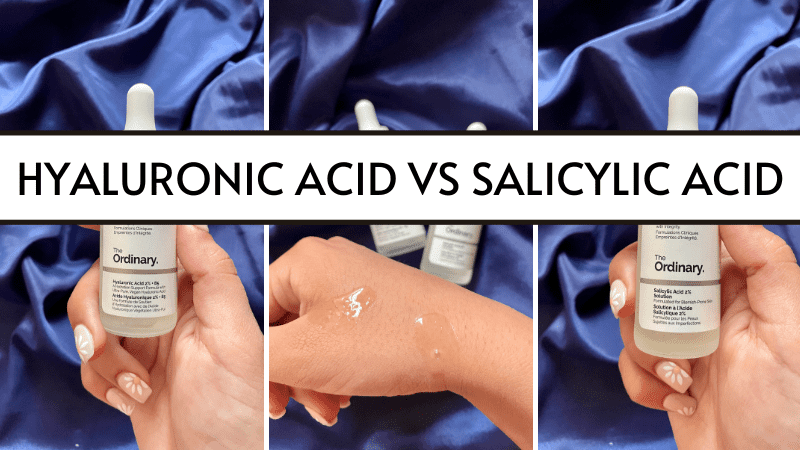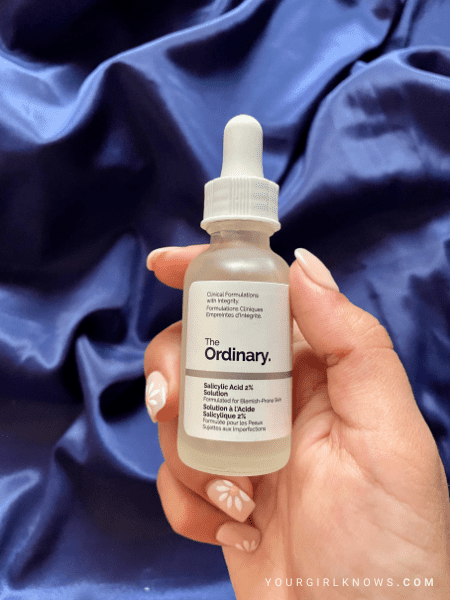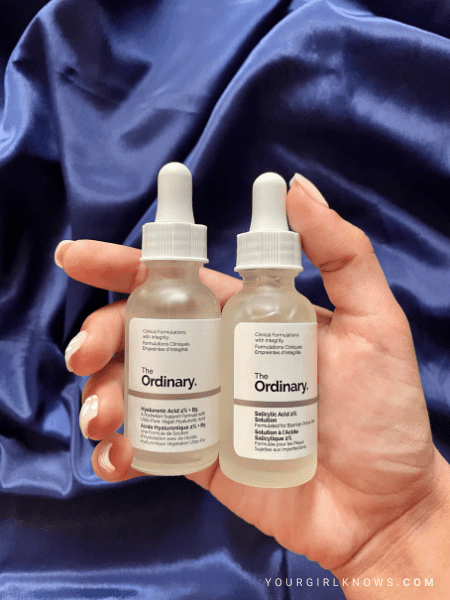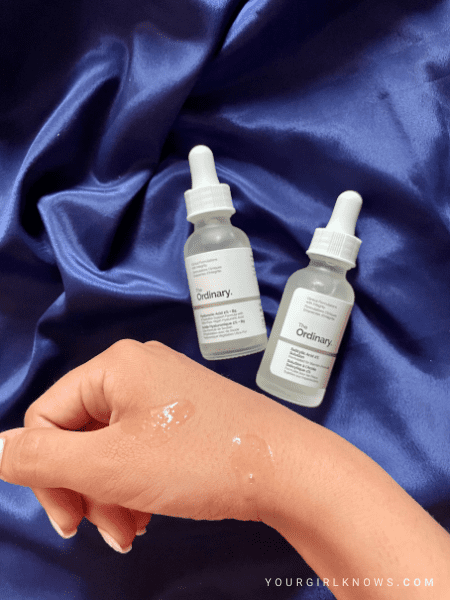Hyaluronic acid vs salicylic acid: what you need to know!

I only recommend products I love and I think you will, too. If you click on links I provide, I may receive a little compensation. Learn more.
From thousands of ingredients, let’s fight the batter of hyaluronic acid vs salicylic acid today!
If you’re an avid skincare enthusiast, then you’ve probably heard of two of the most popular acids used in skin care products – hyaluronic acid and salicylic acid. They are in EVERY. FREAKIN. skincare and makeup products.
But even after being in all the talks, skincare science is one thing that can confuse all the big players. So what, exactly, is the difference between these two powerful skincare ingredients? And which is better for your skin type? Most importantly, can you use hyaluronic acid and salicylic acid together?
Let me answer all these questions and more in just a few minutes! Get your glass of water and read on 😉
What is hyaluronic acid?

Hyaluronic Acid (HA) is a naturally occurring sugar molecule found in your body that helps retain moisture and lock it into the skin. It can hold up to 1000 times its weight in water, so if your skin feels dry or you have fine lines and wrinkles, adding a product with HA will help improve hydration levels. HA also helps protect your skin from environmental damage like UV rays and pollutants.
Can hyaluronic acid cause acne?
Hyaluronic acid does not usually cause acne. In fact, it can be beneficial for skin with acne because it helps to lock in moisture and protect the skin barrier.
There have been reports of people developing small bumps or milia after using hyaluronic acid, but that is usually caused by using too much or using a product with a supremely high concentration of hyaluronic acid. If you know how to use hyaluronic acid correctly, you’ll be safe and even more radiant!
What is salicylic acid?

Salicylic Acid (SA) is another widely used ingredient in skincare products, but it has different benefits than HA. SA is a type of beta-hydroxy acid that helps exfoliate dead skin cells and unclog pores which can help reduce acne breakouts. It also works as an anti-inflammatory agent to reduce redness and inflammation associated with blemishes.
Is it OK to use salicylic acid everyday?
Salicylic acid can be used every day, although it is best to consult with your dermatologist before doing so. Salicylic acid can help to reduce oil production, but if used too frequently, it can lead to irritation or dryness. It is generally recommended to start with a lower concentration of salicylic acid (2% or less) and increase gradually if needed.
SA cleansers are the best way to get started!
What’s the difference between hyaluronic acid and salicylic acid?

The main difference between hyaluronic acid and salicylic acid is the way they work on the skin. Hyaluronic acid is a naturally-occurring substance in the body that helps to maintain hydration, while salicylic acid is an exfoliant that helps to unclog pores and help treat acne by reducing inflammation.
Hyaluronic acid works to keep skin hydrated and supple, while salicylic acid helps to loosen dead skin cells so they can be removed more easily. Both are beneficial for improving the overall look of your skin but serve different functions.
So how do you know which one to use?
Generally speaking, HA is better for all skin types, especially sensitive or dry skin, as it helps plump up the skin and add hydration without causing irritation or drying out the skin. It is a simple product that ensures nourishment to the skin and does nothing more than that. It may indirectly tackle wrinkles and dullness, but it is not what it does at its core.
SA, on the other hand, should only be used by those who have oily or acne-prone skin, as it can be too harsh for other skin types. It basically exfoliates the top layer of the skin gently enough. It directly treats pigmentation, acne, scars, dark spots, sun damage, and even age lines.
Can You use hyaluronic acid with salicylic acid?

Yes, you can use both hyaluronic acid and salicylic acid together in your skincare routine. In fact, HA can hydrate the skin well after SA leaving the skin a bit brittle. However, it is important to note that these two ingredients have different pH levels, so they should be applied at different times.
Furthermore, the correct methods to use hyaluronic acid and salicylic acid are quite different as well, with HA needing damp skin and SA requiring absolutely dry skin before application. So it makes sense to both of them separately and in the right way.
That being said, you can still incorporate these two ingredients into a skincare routine somehow. There’s a way with no side effects, so that’s good news! 😉
How to use hyaluronic acid and salicylic acid together?
When used together, these two acids provide a powerful punch for improving your skin’s appearance and promoting healthy results.
But since there is a conflict between both the products in terms of using it rightly, it often confuses people on their usage.
The very basic guideline for using any skincare product is to stick with a thinner-to-thicker rule. Apply thinner consistency products first and keep layering on with the thicker formulas over. A correct skincare routine usually looks like cleanser < toner < antioxidant serum < eye cream < spot treatment < moisturizer < face oil < sunscreen.
- So, for instance, if you’re using a SA cleanser, and HA serum, you’d use the cleanser first and then the serum.
- If you’re using a SA serum and HA moisturizer, you’d have to layer moisturizer after the serum.
- However, if you’re using both the actives as serums, you’ll apply HA serum first, as it has a higher pH level, followed by SA serum after a minute or two.
That being said, it is not advised to mix the two together as it’ll only make each other ineffective due to varied pH levels.
With regular use of this hyaluronic acid & salicylic acid cocktail, you will notice improvements in your overall complexion, including fewer blemishes, reduced redness/inflammation, and more hydrated & supple-looking skin!
What to apply first, hyaluronic acid or salicylic acid?
Hyaluronic acid should be applied first as it has a higher pH level, then followed by salicylic acid, which is more acidic. Additionally, use a light moisturizer afterward to help balance the skin’s pH levels and prevent irritation.
Can people with dry skin use salicylic acid?
People with dry skin can definitely use salicylic acid. However, it is important to take extra care when using any acid on dry skin. In order to prevent irritation and further drying out, it is advisable to use a hydrating toner or moisturizer before applying the salicylic acid.
Additionally, be sure to use a very low concentration of the acid in order to minimize any skin sensitivity.
Which is better for oily skin, salicylic acid or hyaluronic acid?
Since both the ingredients do very different things and suit oily skin quite well, it all depends on what your priorities are. If you are looking to get rid of breakouts, whiteheads or blackheads, acne scars, or hyperpigmentation, you gotta stick with salicylic acid. While if hydration and plump skin is your aim, opt for hyaluronic acid.
Which acid is best for glowing skin?
For glowing skin, the best acid to use is glycolic acid. Glycolic acid helps to exfoliate dead skin cells and reduce the appearance of wrinkles and fine lines, making the skin look smoother and brighter. It also helps unclog pores and enhance product absorption, giving your complexion a healthy glow. Additionally, glycolic acid is gentle enough to use on all skin types.
Conclusion on hyaluronic acid vs salicylic acid
At the end of the day, both hyaluronic acid and salicylic acid are amazing ingredients that can help improve the look and feel of your complexion—it just depends on what type of results you are trying to achieve! If you want something more hydrating and nourishing, then go for hyaluronic acid, but if you want something more targeted towards blemishes, then opt for salicylic acid instead.
In any case, always remember to patch test first before applying any new product to ensure that it works well with your unique complexion!
related articles to hyaluronic acid vs salicylic acid
- Can You Use Niacinamide And Hyaluronic Acid Together?
- Hyaluronic Acid Vs Retinol: Which Is Better?
- Niacinamide Vs Salicylic Acid: Rivals Or Besties?
- How To Use Retinol- A Complete Guide On Using This Magic Skincare Ingredient!
- How To Use Niacinamide- Do’s And Don’ts You Must Know!


II need to buy a product for removing hard dry skin on the side of my foot, found some products on ebay, one uses Hyaluronic Acid the other Salicylic Acid, what one is best?
Hii Susan, you should use salicylic acid, to get rid of all the accumulated dead skin cells and then apply a thick layer of moisturizer on top of that to soften the area.